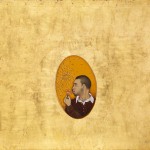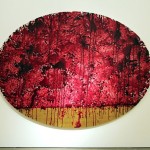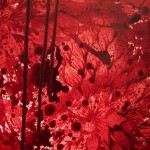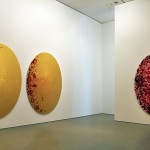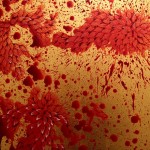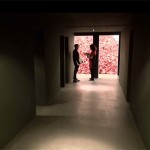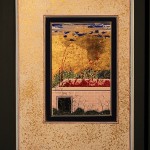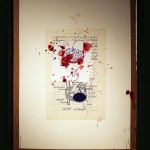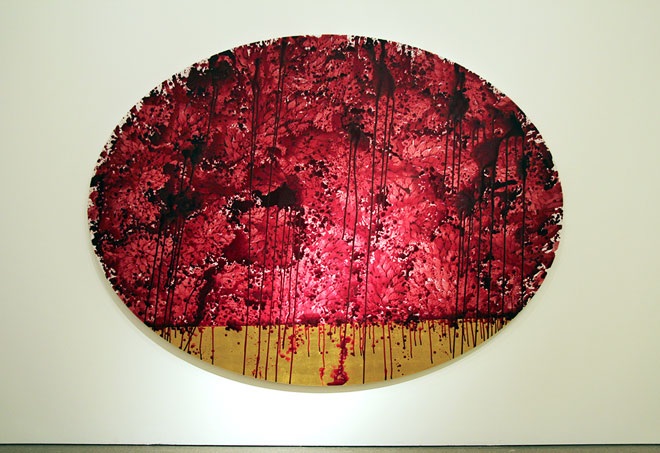
Strolling casually along the streets of Berlin frequently proves to be an especially invigorating experience: the tangible spirit of creativity, nonchalance and dynamism spreads contagiously over the city’s different districts and greatly influences my perception of it. Yet more alluring for the art-loving residents or merely visitors of Berlin than the city’s streets and panorama could be its numerous museums, galleries and exhibition spaces that fuse within the city’s lively atmosphere while forming a world of their own. Placid and animated, traditional and subversive, the art exhibitions in Berlin reveal – from an aesthetically-focused perspective – this inspiring air of creativity that the city as a whole renders.
Even more so, the exhibitions often refine my understanding of the many roles of art. One of those roles, as I have repeatedly come to realize, is to encourage a new level of awareness about world problems which pertain both to our time and dwell outside the chronologically-measured realm. Instilling in me the feeling of readiness to perceive and appreciate beauty in its various manifestations, one of these art showings, the Imran Qureshi: Artist of the Year 2013 exhibition at “Deutsche Bank Kunsthalle” (formerly “Deutsche Guggenheim”), convinced me once again that the power of art can magnificently coalesce aesthetic form with profound content and meaning – without undermining one in order to accentuate the other.
Undoubtedly, the promising title of the exhibition suggests that the Pakistani artist Imran Qureshi had already been a widely renowned artist in the international art scene before being awarded the title “Artist of the Year 2013” on the recommendation of the Deutsche Bank Global Art Advisory Council. Indeed, prior to this award, the artist – apart from having presented his works at various exhibitions, such as the Sharjah Biennial, or Corvi-Mora, London – was also commissioned to paint the roof of the Metropolitan Art Museum in New York City; the Roof Garden Installation opened in May of this year and will thus welcome its visitors until November. Nevertheless, it was here, at the Artist of the Year 2013 exhibition, that I first became acquainted with Qureshi’s art works. It was certainly a most enthralling acquaintance, for, eager to acquire a first-hand experience of the art works, I came to rely on this exhibition as a guide towards my further dialogue with the works of the artist. The exhibition itself is part of a programme initiated by the “Deutsche Bank”, and Imran Qureshi is now the fourth artist to have received the “Artist of the Year” award, following the Slovakian Roman Ondák (2012), the French-born Moroccan Yto Barrada (2011), and the Kenyan-born Wangechi Mutu (2010). Not only were these four artists selected for the award based on the aesthetic particularities of their artworks, but also an essential criterion of their selection for the award constituted their individual ways of approaching social and political issues through art as a medium.
It is this very concern about the social and the political that has been serving as one of the primary triggers for Imran Qureshi’s artistic endeavours. In one of the interviews I read in the exhibition’s “Reading Lounge”, Qureshi tells that since early childhood, he has been interested in the socio-political situation of Pakistan, and came to be a regular reader of newspapers. Later, as a social commentator, he began skilfully transposing his understanding of the social and political condition of his country onto what would become an idiosyncratic aesthetic portrayal of violence, despair and terror weaved tightly with germinating seeds of hope, beauty and rebirth. He has done so through conceiving an exquisite combination of traditional genre motifs and techniques of miniature painting with the formal approach of abstract painting.
Born in 1972 in Pakistan, Imran Qureshi studied and underwent a prolific art practice at the National College of Arts in Lahore, following his major in Miniature Painting. However, much inclined towards abstract art, the artist has been continuously in conversation with and addressing issues related to abstract painting. Furthermore, an exchange of ideas was established between the artist and his colleagues specializing in Painting (its programme including the intense practice and study of abstract art), which proved to be of pivotal influence for his distinct way of addressing the continuation of tradition under the artistic awareness that abstract art can offer. This dialogue between traditional and contemporary practice can be followed in the three parts of Imran Qureshi’s exhibition— ‘abstract’, ‘site-specific’ and ‘traditional’—, at the core of which the themes of ‘violence’, ‘life’, ‘destruction’ and ‘creation’ stand as pillars.
Although I was familiar with abstract painting, the notion and practice of miniature painting opened before me a part of the art world that had previously been for me unexplored territory. Now considered a traditional genre in Pakistan, the contemporary practice of miniature painting – which stems from an old Indian art tradition called musawwari dating back to the Mughal era – seems to also incorporate, to some extent, a few of the aesthetic principles at the base of Renaissance art, such as the emphasis on linear perspective, naturalistic depictions, and the importance given to portraiture.
At the entrance to the exhibition, the Self-Portrait (2009) of the artist in profile meets the visitor. Enclosed in an oval shape and having the gold leaf background serve as a kind of frame, the Self-Portrait strongly conveys a sense of tradition through the media with which it was executed – gouache on wasli paper. Wasli is a type of paper widely used in the Mughal Empire in miniature painting, and is made from several sheets glued together with flour paste and rubbed until shiny and smooth with a glass ball, polished stone or sea shell. The sense of tradition is all the more enforced in the way the artist depicted himself as holding a flower in his hands, and in the way his facial features are modified to meet the aesthetics of that particular culture and era.
Still, the subtle echo of western aesthetic principles within a completely new setting allowed me, as a student of Art and Aesthetics, to identify familiar patterns even within this new artistic configuration. Gazing at the miniature self-portrait, I recalled the visits to “Gemäldegalerie”, where the displayed miniature portraits from the Renaissance period would, despite the differences, still hold much in common with the miniature portraiture of the East. In the contemporary context, however, the strict rules of traditional painting no longer apply: it is no longer sheer preservation of tradition that is of primary concern for artists like Imran Qureshi, but the integration of traditional forms into the vocabulary of contemporary art. In this respect, one can view the golden background enveloping the self-portrait both as a religious or historical element and as a reference to the contemporary meaning gold has acquired, such as the gold leaf in Andy Warhol’s or Yves Klein’s work. It is, therefore, not a subversion of tradition that Imran Qureshi is trying to accomplish, but rather a breaking from tradition in order to discover it from different angles, to revive it and contribute to its proliferation.
With my level of curiosity spiking, and with an ardent desire to treat my eyes and mind to these new aesthetic concepts, I enthusiastically entered the first part of the exhibition – the ‘abstract’. However, instead of finding the expected small-sized samples of contemporary miniature painting, I was appalled to observe from a distance multiple prominent patches of blood-like red paint spilled onto large oval-shaped canvases. Much reminiscent of Jackson Pollock’s ‘attacked’ art works, Imran Qureshi’s works, hung on four white walls as though in dialogue with one another, managed to consolidate the idea of violence by calling to mind a bloody crime scene. Still, upon a closer look at the paintings, it requires no effort to note that within and out of those ‘blood stains’, beautiful red-and-white patterns form their way to the creation of an art work that, besides serving as a means of social and political critique, inevitably represents a reflection upon art and painting itself.
As I tried to visually trace the fine lines merging in fragile floral and foliage elements, I soon felt that my eyes were ‘sinking’ into the intricate details painted with acrylic in an incredible array of nuances. My thoughts strayed to the image of the artist at work: having ‘attacked’ the canvas, he gently brings it to a state of ‘rebirth’, scrupulously and lightly applying his fine squirrel-hair brush onto the ‘wounds’ as if ‘healing’ them with beautiful ornaments. The oval shape of the canvas discreetly points to a sense of protection, of safe enclosure, sheltering this embellishing foliage of lightly fluttering flames, and, as the artist points out, preserving the “fragile thoughts and feelings”. It can also be taken to represent a large-scale translation of portraiture: only instead of clearly defined facial features, the blots of red paint, the ‘blood’ out of which fine lines lavishly emerge, stand for abstract portraits of thousands of people. Red, symbolic of destruction, alludes in Imran Qureshi’s works to the theme of violence, inspired by a terrorist attack on a busy market-place in 2010 in Lahore, by many bomb threats in the area, and also by violent events happening outside of Pakistan. The common ‘language’ of Qureshi’s art works conveys a collective issue of world-wide concern, yet, in spite of the aggressive nature of the prominent red, it also renders the ideas of creation and life. This becomes even more palpable in the passionate way the artist speaks about his home country, and his continuous hope in the further prosperity of the cultural, as well as of the political and social life in Pakistan.
As a continuation of this reflection on violence, destruction, life and creation, the second part of the exhibition consists of an installation, And They Still Seek the Traces of Blood (2013)—a mountain of crushed pieces of printed paper painted in red and ornamented in the same fashion. Thrown one upon the other, the crushed pieces form this amalgamation which does not have a definite peak, as if in the expectancy that many others are soon to join them. The continuously growing mountain of violence appealed to my imagination as a historical documentation of many disasters, wars, revolts, social and political turmoil. One can investigate the mountain of calamities, walk around it, contemplating it from all sides and standing in close proximity to it. Yet in the danger of its continuous growth, one never knows if one is to be soon engulfed by it or not. From the interaction with the art work I was bound to reflect upon our role as observers of, contributors to, and also participants in these troubling events which disrupt life, but, at the same time, are omnipresent.
With these thoughts in mind, I reached the ‘traditional’ part of the exhibition, Opening Word of this New Scripture (2013). A dark and low labyrinth-like space enticed me into its secrets of the past. Twisted corridors had miniature, colourful paintings hanging on the black sinister walls. Their frames, of the same black, blended with the walls. The paintings themselves were avid commentaries on framing, having numerous different-coloured frames painted by the artist inside them. The upper floor, under a different theme, is filled with miniature paintings representing internal organs with medical text in the background. A certain fragmentation of the human body and sense-detachment is conveyed, and the presence of the text with ‘cold’ medical terms only enhances this sense-abolishment. Colourful enough, the miniatures of the ‘labyrinth’ still reflect violence, the red paint hauntingly re-emerging in the depictions. A characteristic of Indian traditional miniature painting of the Mughal period is the mandatory depiction of a figure, life scene, royal history, romance, religious story, or exotic flora and fauna, which could serve as subject-matter for the paintings. Imran Qureshi replaced the figurative narrative with a different artistic sensibility and aesthetic idea by painting flat, two-dimensional self-referential scenes. He challenged the tradition of depicting a clearly defined figure, and chose to paint instead a hanger with a shirt, out of which fine ornaments spring and fuse with the nature in the background. There is no typical representation of a figure, and instead, one is free to fill this ‘absence’ or ‘coldness’. It soon occurred to me that not only the artist is the one to have obtained more freedom by breaking the rigid boundaries of tradition, but also I, the beholder, accompany the artist in doing so by trying to ‘read’ his art works.
Rooted in tradition, Imran Qureshi’s art practice has emerged as a fresh, continuous stream for the art scene of Pakistan, and no less for the international one. Preserving the distinct national practice of miniature painting, Qureshi now teaches at the university from which he graduated, and also translates this old art into a universal language that everybody can access, even if differently. Formed out of so many layers, his work manages to speak subtly to any kind of audience. So it spoke to me, as a lover of art and a human being, as a small red dot, a fine graceful line, an abstract portrait to be found among the many lively flaming ones in the protective shell of a canvas.
Photo gallery:

